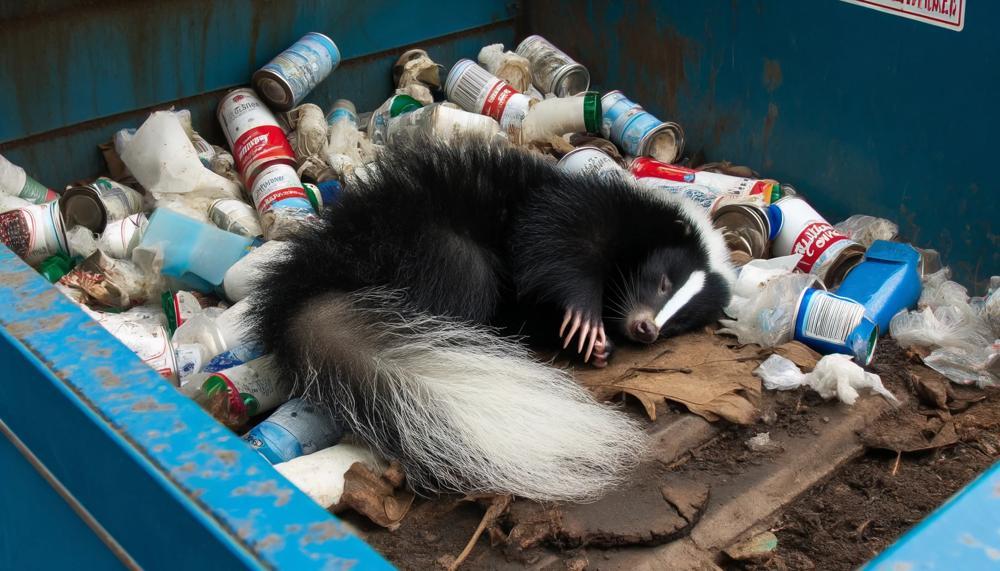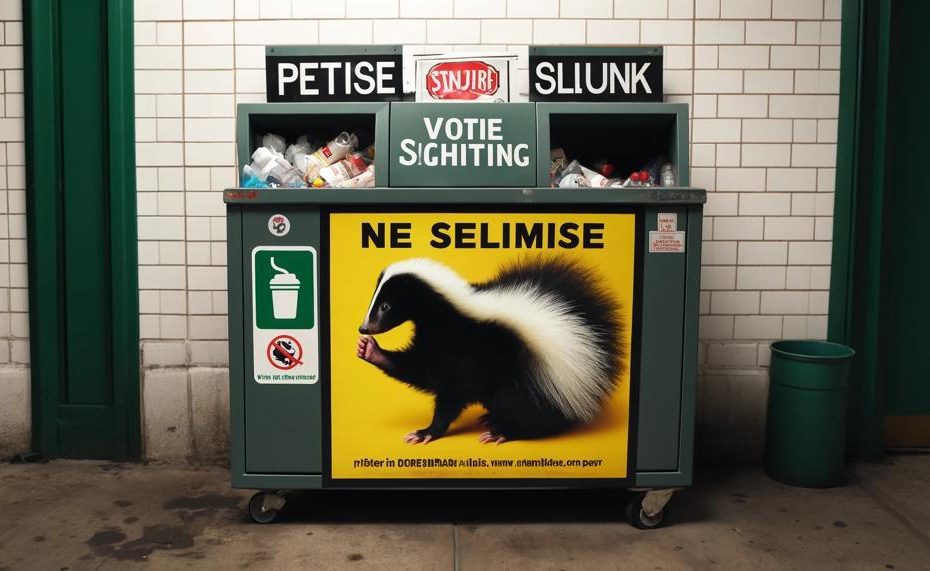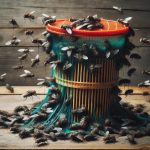Dealing with a dead skunk isn’t exactly something you’d talk about at a dinner party, but it’s something that all homes, farmers, and wildlife lovers need to know how to do. It can be annoying to find a dead skunk on your property because they have a bad smell, but it’s important to handle the situation carefully to avoid more problems.
In this blog post, we’ll show you how to handle this tricky situation with care.
So, how to dispose of a dead skunk properly?
You can throw away a dead skunk by putting it in a trash bag, sealing it tightly, and taking it to a dump or bin. Keep the skunk away from the trash, because it will still smell bad. You could also burn the body as soon as possible.
When you touch a dead skunk, you should wear gloves and a nose plug. These other ideas might also help keep skunks out of your yard:
- Put down fences around your decks, porches, garages, and barns.
- Take away food sources.
- Get your yard clean.
- Use lights with motion sensors
- Think about capsaicin.
- Get them out of their den (but be careful).
- Do not use mothballs or ammonia.
- Do not use poison on beetle grubs.
Let’s dive in now.
Contents
How To Dispose Of A Dead Skunk Properly
Disposing of a dead skunk safely and without causing contamination or spreading of disease is a task that requires a bit of know-how and precaution.
Below is a step-by-step guide crafted to assist you in this somewhat delicate task:
| Step | Action | Details |
| 1 | Preparation | Don protective gear: gloves, a mask, and long sleeves to avoid direct contact with the carcass or any potential parasites and bacteria. |
| 2 | Locate and Bag | Use a shovel or a similar tool to carefully scoop up the carcass. Place it into a sturdy plastic bag, avoiding any contact. |
| 3 | Secondary Bagging | For added safety, place the first bag into a second plastic bag to double-bag the carcass, reducing the risk of leakage and odor. |
| 4 | Disposal | Check with local regulations on wildlife carcass disposal. Options typically include burial in a secluded area or incineration. Ensure the burial site is deep enough to prevent scavengers from uncovering it. |
| 5 | Sanitise Area | Clean the area with a mixture of bleach and water to disinfect any spots where the skunk might have lain or decomposed. |
| 6 | Odour Elimination | To tackle any remaining odour, use a commercial or homemade odour eliminator suitable for outdoor use. Sprinkling lime over the burial site can also help neutralise smells. |
| 7 | Professional Help | If the task feels overwhelming, or if you’re unsure about local wildlife carcass disposal regulations, contacting animal control or a professional wildlife removal service is advised. |
Remember, while dealing with a deceased skunk, speed is of the essence to prevent the spread of disease and to reduce the impact of its potent odour.
Can you bury the dead skunk?
Burying a dead skunk in your backyard can be done, but it’s not always the top pick for disposal. Here’s a rundown of what you need to know to handle this task smartly and safely.
Safeguard Measures
Before diving into the burial, it’s critical to deck yourself out in protective gear. Gloves and a long-sleeved shirt are the bare minimum to keep you safe from potential diseases that the skunk could be carrying.
Proper Burial Depth
Dig a grave that’s deep enough to deter any nosy animals from uncovering your burial site. A good rule of thumb is to aim for at least 3 feet deep. This depth helps keep the scent buried, too, which is key when you’re dealing with a skunk.
Location, Location, Location
Choosing the right spot in your backyard is pivotal. Steer clear of areas near water sources or where you plan to dig in the future, like gardens or utility lines. You want to minimize the risk of contamination or accidental exhumation.
Alternative Disposal Methods
While burial is a viable option, sometimes it’s not the most practical. In urban areas or where digging is hard, consider reaching out to your local animal control or waste management services for guidance on disposing of the carcass safely and according to local regulations.
Remember, dealing with a dead skunk isn’t just about getting rid of an unwanted guest; it’s about doing it in a way that’s safe for you, your family, and the environment.
What can you do about the smell?
When you’re up against the robust, lingering stench of a deceased skunk, the key is swift action and the right mix of home remedies.
Here’s a straightforward guide, tailored for those in the thick of this rather pungent problem, to reclaim the freshness of your surroundings.
| Target | Solution | Notes |
| Pets | Hydrogen peroxide, baking soda, dish soap mix | Apply for 5 mins, rinse off, avoid eyes |
| Outdoors | Vinegar and water | Avoid using in pressure washers |
| Fabrics | Baking soda and laundry detergent | Use hottest wash setting, or steam for large items |
| Home Air Quality | Change HVAC filters | Prevents lingering odors |
By adhering to these steps promptly, you stand a good chance of banishing that dreadful skunk odor, making your space livable once more.
Each method is straightforward, employing household items, ensuring you’re not left scrambling for exotic ingredients or costly solutions. And remember, the essence of tackling skunk odors?
What can you do about the smell?
To banish the rank scent of a deceased skunk, you’ll need a plan that’s as stubborn as the smell itself. The stink, a sulphuric concoction, can linger like unwanted house guests.
Here’s a sturdy approach to evict that pungent odour from your surroundings.
Immediate Action
- Isolate the Area: Keep the affected space well-ventilated; open windows and use fans to disperse the smell.
- Remove the Source: If possible, carefully remove the skunk’s remains. Utilise protective gear to avoid contamination and double-bag the carcass before disposal.
Cleaning Up
- Wash Surfaces: Use a mixture of bleach and water (1 part bleach to 10 parts water) to cleanse affected hard surfaces.
- Fabric Care: For smelly fabrics, washing with a mix of laundry detergent and baking soda can help. Adding vinegar to the rinse cycle breaks down the odour molecules.
Odour Neutralization
| Material | Method | Application |
| Vinegar | Spray or bowl | Place bowls of vinegar in the room or spray affected areas to neutralize odours. |
| Baking Soda | Scatter | Spread on carpets or upholstery, let sit, then vacuum. |
| Hydrogen Peroxide Solution | Wash | Mix with dish soap and baking soda, apply to affected areas, wait, then rinse. |
Long-Term Solutions

- Air Purifiers: Install air purifiers with HEPA filters to continuously cleanse the air.
- Professional Help: Sometimes, the scent embeds itself too deeply. Specialists in odour removal can offer solutions that are both thorough and lasting.
Conclusion
Disposing of a dead skunk is a difficult job that requires care for nature, common sense, and a lot of safety.
This guide has cleared the way through the maze of problems that come up in this kind of situation, focusing on the important needs for safety, knowing the law, and managing smells well. With safety gear on, one steps into the breach, ready to deal with the risks of contamination and strong smells.
The plan includes a careful way of removing bodies, with a focus on giving the dead respect and taking care of the surroundings. You can choose between burying the skunk or getting professional help. Whichever you choose, the skunk’s unpleasant smell will be much less noticeable.
Dealing with skunks isn’t just a chore; it’s a promise to protect health, follow wildlife laws, and bring peace back.





